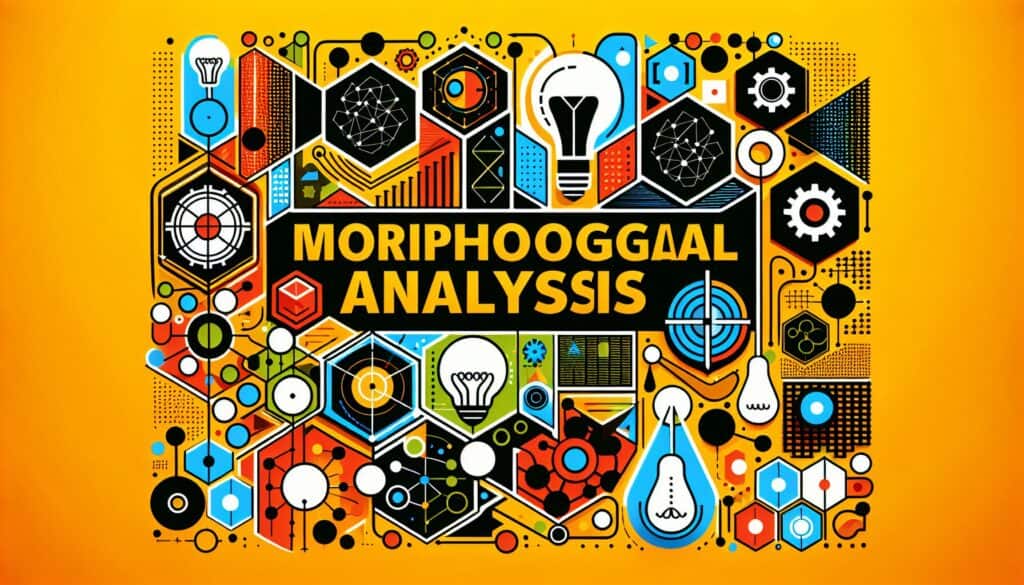A problem-solving and ideation technique that involves breaking down a complex problem or system into its fundamental parameters or dimensions, then generating all possible combinations of these to find novel solutions.
- Méthodologies : Clients et marketing, Idéation, Conception de Produits
Analyse morphologique

Analyse morphologique
- Créativité, Conception pour la fabrication additive (DfAM), Optimisation de la conception, Pensée conceptuelle, Idéation, Innovation, Techniques de résolution de problèmes, Langage de modélisation des systèmes (SysML), Ingénierie de la valeur (EV)
Objectif :
Comment il est utilisé :
- Identifies the key features or functions of a product/problem. For each feature, a list of possible variations or implementations is generated. Combinations of these variations are then explored systematically.
Avantages
- Provides a systematic way to explore a wide range of potential solutions or configurations; can lead to innovative and unexpected ideas; helps ensure all possibilities are considered.
Inconvénients
- Can become very complex and generate an overwhelming number of combinations if there are many parameters or variations; evaluating all combinations can be impractical; requires clear definition of parameters.
Catégories :
- Idéation, Résolution de problèmes, Conception de Produits
Idéal pour :
- Systematically structuring and exploring all possible solutions to a complex problem by breaking it into its core dimensions and generating combinations.
Morphological Analysis is frequently utilized in industries such as automotive design, aerospace engineering, and consumer electronics, where the intricacies of product features and functions necessitate thorough examination. During the conceptual phase of projects, teams typically comprising engineers, designers, and product managers initiate this methodology to dissect the multifaceted nature of challenges they face. By identifying the fundamental features of a product or problem, such as size, material, or functionality, and generating variations for each, teams can explore a vast array of combinations that might lead to groundbreaking solutions. For example, in automotive design, variations might include different types of propulsion systems (electric, hybrid, traditional combustion) combined with varied body styles (sedan, SUV, coupe), which can yield numerous innovative vehicle concepts. This structured exploration fosters creativity, facilitating the emergence of previously unconsidered solutions that enhance product appeal while addressing user needs or environmental concerns. Workshops and collaborative sessions are often organized around this methodology, allowing diverse input and interdisciplinary cooperation, which not only broadens the exploration process but also aligns the team’s focus on achievable, coherent outcomes.
Principales étapes de cette méthodologie
- Identify the core dimensions of the problem or product.
- Define key features or functions related to each dimension.
- Generate a comprehensive list of possible variations for each feature.
- Create a morphological matrix to combine variations systematically.
- Explore different configurations by analyzing the matrix.
- Select and evaluate promising combinations for feasibility and relevance.
- Refine configurations based on feedback and insights gained.
- Document the selected combinations for further development and prototyping.
Conseils de pro
- Utilize clustering techniques during the variation generation phase to identify synergies among features, enabling stronger combinations that may not be immediately apparent.
- Integrate feedback loops from stakeholders at various stages of the analysis to validate and refine the combinations, ensuring relevance and applicability to real-world scenarios.
- Employ simulation tools to visualize and test the feasibility of the selected combinations, allowing for quicker iterations and adjustments before moving to physical prototypes.
Lire et comparer plusieurs méthodologies, nous recommandons le
> Référentiel méthodologique étendu <
ainsi que plus de 400 autres méthodologies.
Vos commentaires sur cette méthodologie ou des informations supplémentaires sont les bienvenus sur le site web de la Commission européenne. section des commentaires ci-dessous ↓ , ainsi que toute idée ou lien en rapport avec l'ingénierie.
Contexte historique
1949
1950
1950
1960
1960
1960
1960
1940
1950
1950
1958
1960
1960
1960
1960
(si la date est inconnue ou n'est pas pertinente, par exemple "mécanique des fluides", une estimation arrondie de son émergence notable est fournie)















Articles Similaires
Questionnaires sur les troubles musculo-squelettiques
Tests à plusieurs variables (MVT)
Analyse de régression multiple
Systèmes de capture de mouvement
Méthode MoSCoW
Test de la médiane de Mood